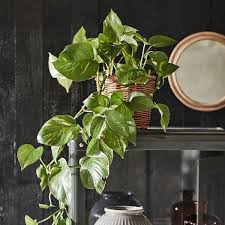Pothos: The Perfect Indoor Plant for Your Home
Discover the beauty of pothos, also known as Epipremnum aureum. This popular indoor plant is cherished for its stunning foliage and low-maintenance care, making it an ideal choice for any home.
6/3/20255 min read


Understanding Pothos Varieties
Pothos, known scientifically as Epipremnum aureum, is a highly sought-after houseplant due to its striking foliage and ease of care. Various types of pothos have unique features that cater to different aesthetic preferences and growth habits. This exploration will cover some popular varieties including Golden, Neon, Snow Queen, Manjula, Satin, Marble Queen, and N-Joy pothos, providing insights into their distinct characteristics.
The Golden pothos is easily recognizable for its heart-shaped leaves adorned with vibrant yellow variegation. This variety thrives in a range of light conditions, making it a versatile choice for both beginners and seasoned gardeners. Its adaptability allows it to grow exceptionally well in low-light environments, although brighter light enhances its growth.
Neon pothos, characterized by its bright lime-green leaves, offers a bold aesthetic appeal. This variety’s striking color can brighten up any indoor space, complementing various décor styles. Unlike the more traditional golden variant, the Neon pothos tends to be more compact, often trailing in hanging baskets or adorning shelves.
The Snow Queen features creamy white and green variegation, creating an elegant look that stands out. Its unique coloration not only offers visual interest but indicates a strong growth habit when exposed to indirect light. Similarly, the Marble Queen’s beautiful marbled patterns make it an attractive option, with a mix of white and green hues that provide a dramatic effect in any arrangement.
Manjula pothos is another variant celebrated for its large, heart-shaped leaves, blending rich greens with bursts of white and cream. It is particularly favored for its unique trait of producing a diverse leaf pattern, which can vary significantly from one leaf to another. Alongside this variety, the Satin pothos showcases silvery hues on its dark green leaves, creating a stunning contrast that reflects light beautifully.
Lastly, the N-Joy pothos embodies a unique appeal with its small, heart-shaped leaves that feature a blend of pure white and green colors. These traits make them particularly attractive to those seeking a smaller, more ornamental variety. Understanding the differences among these pothos types can significantly benefit buyers seeking to find their ideal plant locally, enabling them to select the right variety that aligns with their preferences and home environment.
Where to Find Pothos Plants Near You
Finding pothos plants locally can be a rewarding experience, as these popular houseplants become increasingly sought after for their hardiness and aesthetic appeal. One of the best places to start your search is at local nurseries and garden centers. These establishments often carry a variety of pothos species, including Epipremnum aureum (Golden Pothos) and Marble Queen Pothos, offering the opportunity to see the plants in person and select the healthiest specimens. Visiting during peak seasons, typically in the spring and summer, can yield a wider selection.
In addition to nurseries, consider exploring large chain retail stores that have dedicated gardening sections. Many of these stores stock pothos plants and may even have ongoing sales or promotions. When browsing in a physical store, pay close attention to the condition of the plants. Look for vibrant leaves, minimal yellowing, and strong growth as indicators of a healthy pothos plant.
If local options are limited, online plant retailers are an excellent alternative. Many allow customers to order pothos plants online with the option of in-store pickup. When choosing an online vendor, it is crucial to read customer reviews and check for reliable delivery practices to ensure plant quality upon arrival. Some retailers offer guarantees on the health of the plants, which can provide peace of mind when purchasing online.
Regardless of where you choose to shop, asking the right questions can help you make informed decisions. Inquire about the plant’s care requirements, origin, and whether they have been treated for pests. This information will assist you in selecting a pothos plant that will thrive in your home environment and make the most of your investment.
Caring for Your Pothos Plant
Caring for your pothos plant is crucial to ensure its health and vibrant growth. Pothos, known for its resilience and adaptability, thrives best in bright, indirect light. While it can tolerate low light conditions, too little light can hinder growth and diminish the plant's variegation. If placed in direct sunlight, the leaves may scorch, leading to irreversible damage. Regularly rotating your plant can help distribute light evenly and promote balanced growth.
Watering is another essential aspect of pothos care. It is important to allow the top inch of soil to dry out between waterings. Overwatering can lead to root rot, a common issue faced by pothos owners. A general rule of thumb is to water your pothos every one to two weeks, depending on the humidity and temperature of your environment. It is advisable to adjust your watering schedule during different seasons; for example, during the winter months, your pothos may require less frequent watering due to reduced growth.
The type of soil you choose also plays a significant role in the health of your pothos plant. A well-draining potting mix is ideal, as it prevents excess moisture and provides the necessary nutrients. A mixture designed for houseplants, which includes components like peat moss and perlite, is typically suitable. Additionally, repotting your pothos every couple of years can help refresh the soil and provide space for growth.
Lastly, be vigilant about potential pests that may target your pothos. Common issues include spider mites, mealybugs, and aphids. Regularly inspecting your plant and addressing infestations promptly can help keep your pothos healthy. Overall, a combination of optimal light, proper watering, suitable soil, and pest management will ensure that your pothos plant flourishes throughout the year.
Benefits of Having Pothos in Your Home
Pothos, scientifically known as Epipremnum aureum, is a highly regarded houseplant that offers a myriad of benefits, making it a popular choice for indoor gardening enthusiasts. One of the primary advantages of having pothos in your home is its remarkable ability to purify the air. Numerous studies have shown that this resilient plant can effectively remove harmful toxins, such as formaldehyde, benzene, and xylene, from indoor environments, contributing to improved air quality. By incorporating pothos into your living space, you not only enhance the aesthetics but also promote a healthier atmosphere for you and your family.
Apart from its air-purifying qualities, pothos adds considerable aesthetic appeal to any room. Its vibrant green leaves, which can vary in shape and variegation, effortlessly elevate the visual interest of your home décor. Pothos can be displayed in various ways, including hanging baskets, shelves, or even as a tabletop centerpiece. The versatility of this plant allows it to adapt to different styles, from modern to rustic, making it an excellent addition for individuals seeking to beautify their living spaces.
Moreover, the ease of care associated with pothos makes it an ideal choice for both novice and seasoned gardeners. This hardy plant thrives in various light conditions, from low-light areas to bright, indirect sunlight. Additionally, it requires minimal maintenance, needing only infrequent watering and occasional pruning to promote growth. This low-investment care routine enables more individuals to enjoy the benefits of indoor gardening, regardless of their experience level.
In conclusion, the pothos plant stands out as an excellent indoor companion due to its air-purifying capabilities, decorative appeal, and low-maintenance requirements. By considering adding pothos to your home, you can enjoy both a healthier living environment and an enhanced aesthetic experience.
